- Butternut squash can be started from seed indoors and does well direct seeded outdoors once the weather is warm. It is a warm-weather crop and does not tolerate frost.
- If starting butternut squash seeds indoors, plant 1-2 seeds in a single pot or a seed starting tray cell. Use a quality fertile soil mix to start seeds indoors successfully. Sow the seeds about ½ to 1 inch deep. Cover with soil and water thoroughly. Keep the soil moist as seeds need moisture and warmth to sprout. Use a humidity dome to preserve moisture in the soil. Start the seeds about 3 weeks before the last frost indoors under the grow lights of south-facing windows. Ensure the seedling has adequate light to prevent it from becoming leggy.
- Water the butternut squash seedlings every day, the larger they grow the more watering they need. Ensure the soil is moist but not damp.
- Once the plant has 2 sets of true leaves and a well-established root system which takes 4-5 weeks from starting the seeds, prepare the seedling by hardening them off before they are transplanted outdoors.
- Butternut squash likes loamy, well-draining, fertile soil full of organic matter. Amend the soil with organic matter like compost, worm castings, leaf mould, or well-aged animal manure.
- Plan the seedlings or direct seed the butternut squash seeds when the danger of the frost is over and the temperatures are constantly above 60F.
- Plant butternut squash in a sunny location providing them with about 6 hours of sun.
- Fertilize and water deeply regularly. Always check the soil before watering. Water about 1-2-inch-deep weekly.
- Ensure the female flowers are well pollinated and hand pollinate if needed.
- Harvest once the butternut squash is mature by reaching a uniform tan color and the stem the fruit is attached to the plant is dry. When harvesting leave about 1 inch of the stem on each fruit.
- Cure the butternut squash fruit in the sun for about 7-10 days. Curing butternut squash means hardening the skin further and healing any cuts and bruises to winter storage. The harder the skin, the longer the fruit will last over winter.
- During the growing process, inspect the plant regularly for any pests. Squash bugs, vine borers, and cucumber bugs are the most common pests to be attracted to butternut squash. Eliminate the pests by picking them by hand or spraying them with soapy water, by mixing about 6-7 tablespoons of degreaser dish detergent with a gallon of water. Spray the bugs down with this mixture, and repeat as needed.
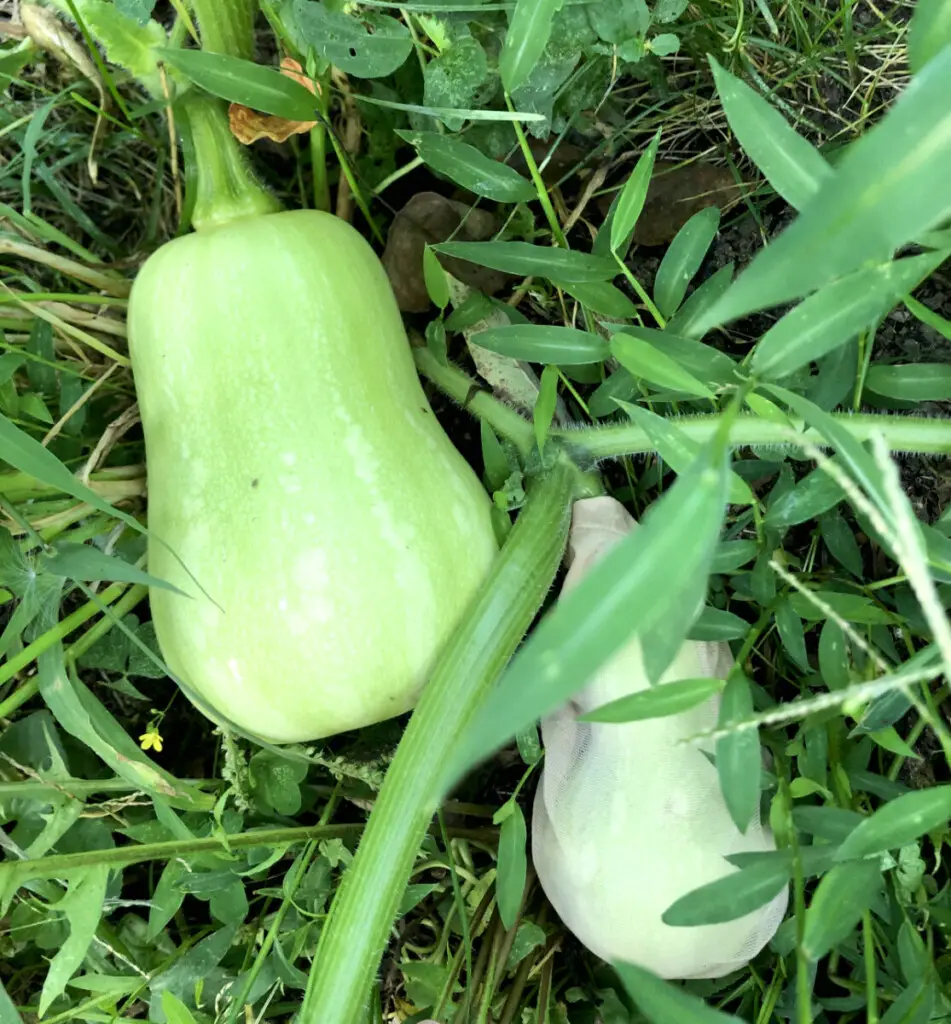
How to start seeds and care for seedlings
What month should I plant butternut squash?
Plant butternut squash indoors about 3 weeks before the last frost date. Butternut squash can be planted directly in the garden from May till early June after the last frost has passed and the soil has warmed up to 60F.
I start my butternut squash indoors in seed trays before the last frost and then sow again directly in the garden end of May. Butternut squash is a must and a regular staple in my pantry stocking garden because they are so easy to grow and store. I store them simply sitting on the shelf in the basement. Nothing extra is needed. I make roasted butternut squash soup or just eat them roasted.
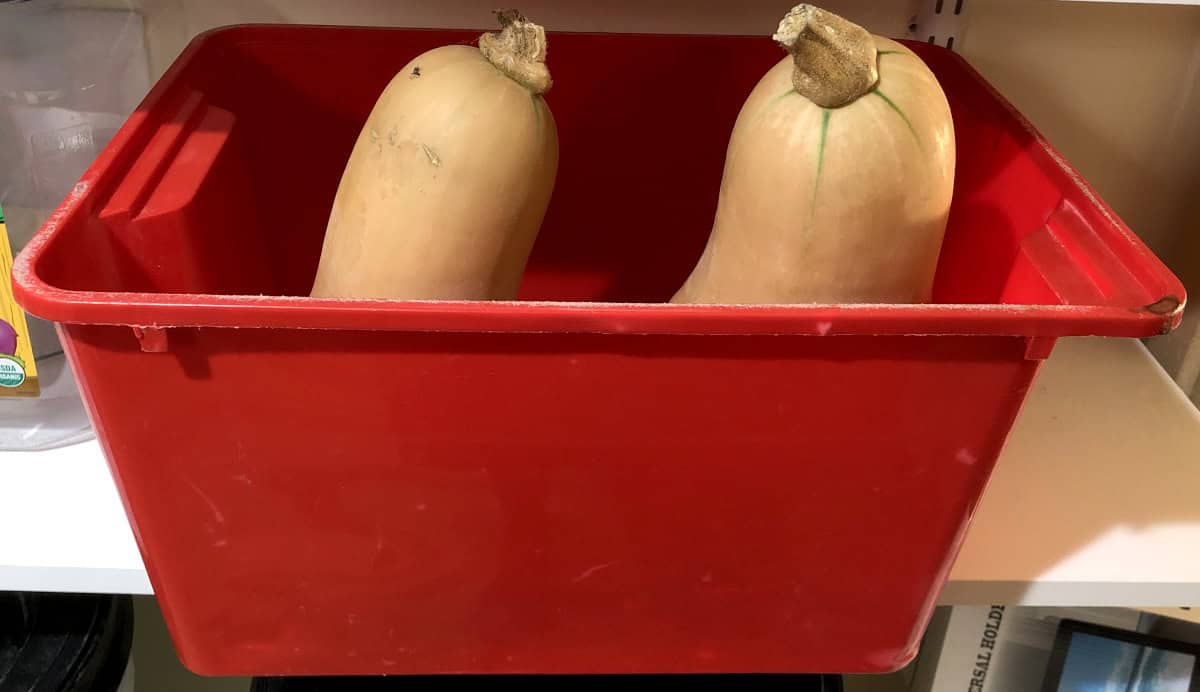
Butternut squash is also my favorite vegetable to grow because of how large the fruit gets. You get multiple fruits off of one plant and they get big and heavy. Awesome vegetable! Can be used in desserts too!
I save my own seeds so it is basically free to grow butternut squash! A pantry stocking garden must!
Most high-yielding fruits and vegetables to grow in pantry stocking garden
To save space, I always grow butternut squash on a trellis, mostly on tomato cages. As the plant grows, I wrap it around the cage. If you grow a small garden then grow butternut squash vertically like me!
How long does it take to grow butternut squash?
Most butternut squash takes 100-120 days to grow from seed to harvest. How long butternut squash grows also depends on the cultivars. For a shorter growing season, pick a butternut squash cultivar that takes shorter days to grow.
TIP: I wrap butternut squash and spaghetti squash fruits in knee high stockings to protect them from pests laying eggs in them and infesting them, and from rodents and other wildlife eating it. The stockings expand as the fruit grows while providing protection. One of the best tips I’ve learned gardening!
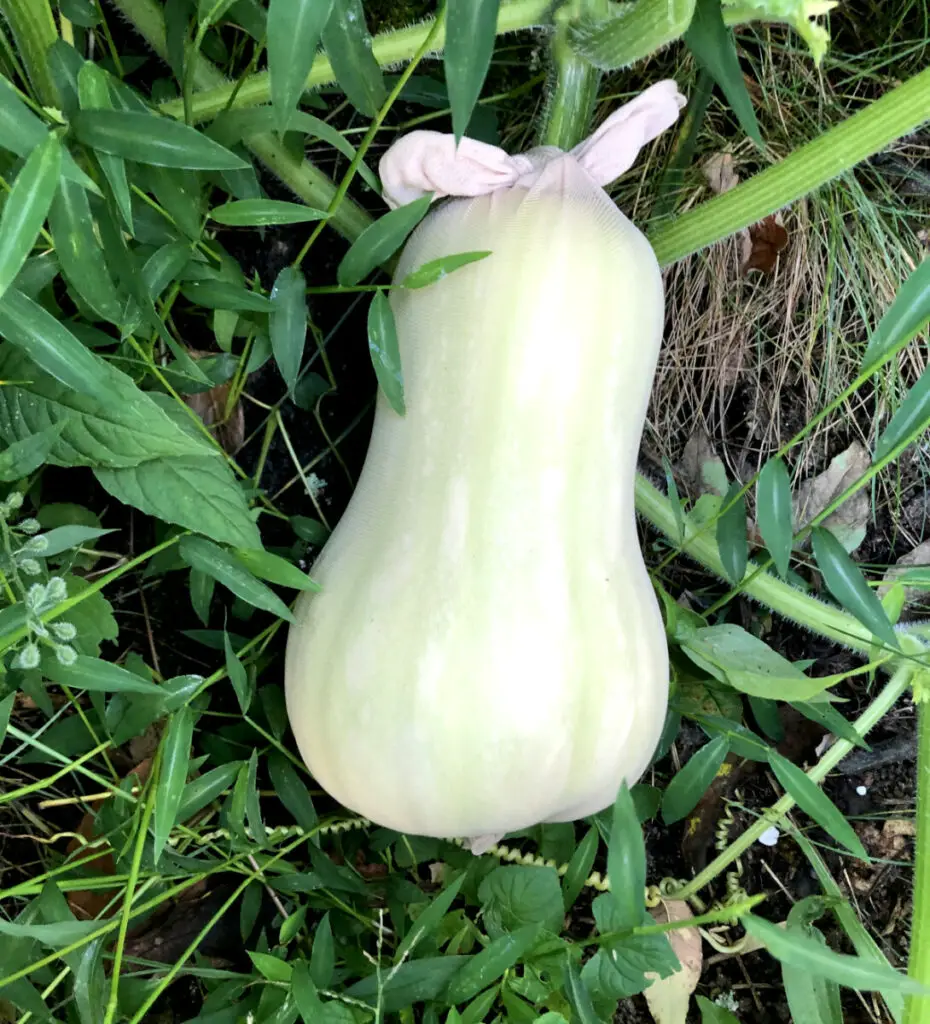
Where is the best place to plant butternut squash?
A sunny location with a level lot is the best place to grow butternut squash. Butternut squash needs at least 6 hours of sun daily. If growing butternut squash on a trellis, provide support to climb on. If growing butternut squash on the ground, ensure there is enough space for the plant to grow as it will get anywhere from 4-12 feet long depending on the cultivar. Also ensure the location is easily accessible for you to water, fertilize and harvest the plant.
Does butternut squash come back every year?
Butternut squash does not come back every year. Butternut squash is an annual vegetable and only lasts one life cycle. New plants must be grown from seed every year.
Will butternut squash climb a trellis?
Yes, butternut squash is a vining plant which means it will climb the trellis after it has been trained. Help the young butternut squash plant upwards and around the trellis at the young stage and it will grow upwards on the trellis after that.

I grow my butternut squashes on trellises. I use tomato cages to grow my vining plants as they are the easiest, handiest, and most affordable support for vining plants. Tomato cage support allows me to plant butternut squash anywhere I like and just stick a tomato cage around it. Tomato cages are reusable and lightweight.
Do butternut squash plants need a lot of water?
Yes, butternut squash as well as all squash plants like water. Provide them with 1-2 inches of water weekly, depending on the climate your growing space is located. Water butternut squash deeply at the base of the plant. When hot summer hits and the temperatures are high it might need more watering, therefore always check the soil for watering. Mulching around the plant helps preserve moisture in the soil and keeps the plant from drying out.
A GOOD READ: How and when to water vegetable garden AND Should you water garden in the morning or at night?
When to harvest butternut squash?
Harvests butternut squash when the fruit is tan in color and the stem with which the fruit is attached to the plant is dry. The dry fruit stem is the best indication that the fruit is ready to be harvested.
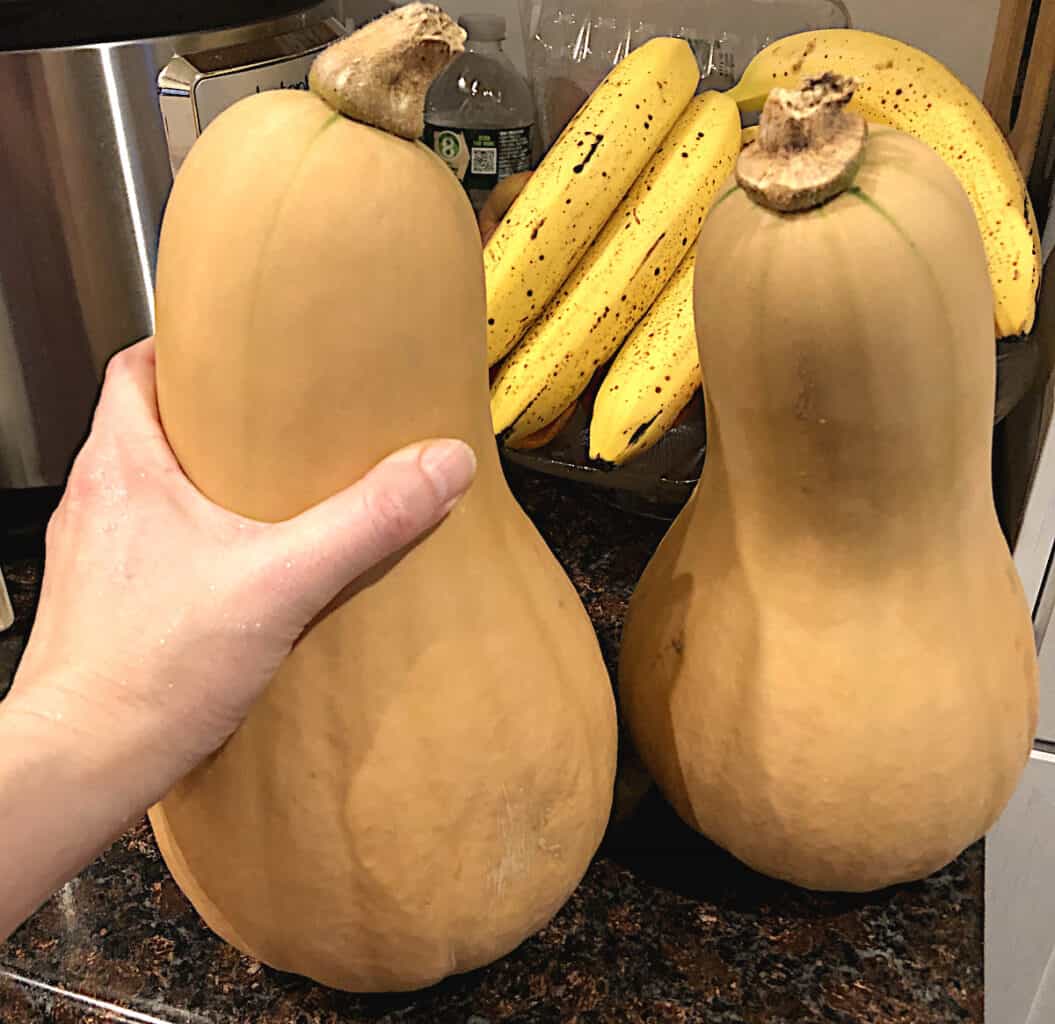
How do you keep squash off the ground?
Keep squash off the ground by laying it on a piece of cardboard, a sheet of wood, or a wooden plank. Or grow squash on the trellis so the fruit hangs down and does not touch the ground.
How do I keep squash plants from taking over my garden?
To keep squash plants from taking over the garden, simply grow them on trellises or around tomato cages.
Will butternut squash mature after picking?
Yes, butternut squash will mature after picking if harvest a week or two earlier than it should be. Let it set on a sunny window or a sunny location and it will mature.
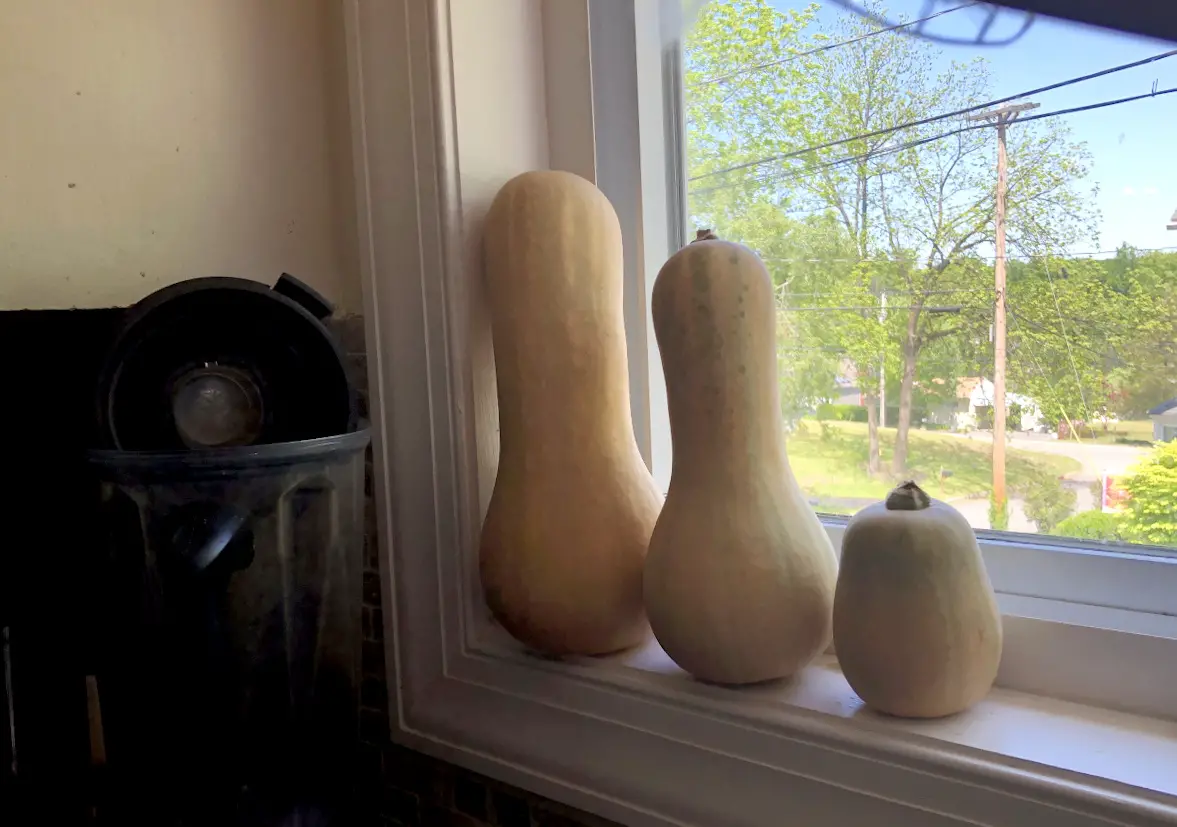
Last year I planted some of my butternut squashes too late and had to harvest them before the hard frost would destroy them. The color of the fruit was still light green and the stems were green as well. I simply let them sit on my windowsills till they matured. They did well, although some of the very immature fruit did not make it, most of the larger fruit did very well maturing indoors in the sun. In fact, I still have some sitting on my kitchen window as I am writing this! They have been sitting there since November, zone 6, and now it’s already May.
It is a very forgiving plant to grow and very forgiving fruit to store as you can see. Would recommend growing it for beginners, using tomato cages for support so it does not overtake the garden.
Why is my butternut squash not fruiting?
Butternut squash not fruiting because the female flower was not sufficiently pollinated or was not pollinated at all. You can help your butternut squash fruit by providing proper care and hand pollinating it using a small paintbrush. Take the pollen from the male flower using the brush and apply it to the female flower.
How to fertilize butternut squash?
Fertilize butternut squash plants with liquid fertilizer biweekly or as per the instructions on the packaging of your preferred fertilizer instructs. Feed your butternut squash plant with fertilizer rich in potassium and phosphorus.
This year I am using this concentrate fertilizer that I dilute by 10 mil in 1 gallon of water then I apply at the base of the plant if possible. What is good about this fertilizer is that it did not burn my plants in any way and I can mix it as strongly or as gently as I wish.
Butternut squash is always on my planting list every growing season and it is a great pantry-stocking vegetable overall.
Please share with me and the readers, what is that your favorite variety of winter squash and why.
How and when to water vegetable garden
Should you water garden in the morning or at night?

